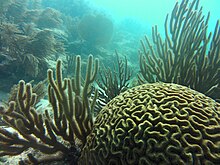
Pillar coral is a hard coral found in the western Atlantic Ocean and the Caribbean Sea. It is the only species in the monotypic genus Dendrogyra. It is a digitate coral -that is, it resembles fingers or a cluster of cigars, growing up from the sea floor without any secondary branching. It is large and can grow on both flat and sloping surfaces at depths down to 20 m (65 ft). It is one of the few types of hard coral in which the polyps can commonly be seen feeding during the day.
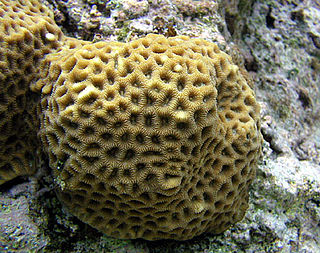
Brain coral is a common name given to various corals in the families Mussidae and Merulinidae, so called due to their generally spheroid shape and grooved surface which resembles a brain. Each head of coral is formed by a colony of genetically identical polyps which secrete a hard skeleton of calcium carbonate; this makes them important coral reef builders like other stony corals in the order Scleractinia. Brain corals are found in shallow warm water coral reefs in all the world's oceans. They are part of the phylum Cnidaria, in a class called Anthozoa or "flower animals". The lifespan of the largest brain corals is 900 years. Colonies can grow as large as 1.8 m (6 ft) or more in height.

Porites astreoides, commonly known as mustard hill coral or yellow porites, is a colonial species of stony coral in the family Poritidae.

Pavona duerdeni, the porkchop coral, is a coral that forms clusters of cream-colored lobes or discs. They grow in large colonies, divided into ridges or hillocks. The coral is considered to be uncommon due to its low confirmed abundance, yet they are more commonly found in Hawaii, the Indo-Pacific, and the Tropical Eastern Pacific. They make up some of the largest colonies of corals, and have a slow growth rate, as indicated by their dense skeletons. Their smooth appearance is due to their small corallites growing on their surface.

Eusmilia is a genus of stony coral in the family Meandrinidae. It is a monotypic genus represented by the species Eusmilia fastigiata, commonly known as the smooth flower coral. It is found on reefs in the Caribbean Sea.

Siderastrea siderea, commonly known as massive starlet coral or round starlet coral, is a stony coral in the family Siderastreidae. It is found in shallow parts of the western Atlantic Ocean as solid boulder-shaped or domed structures.

Siderastrea radians, also known as the lesser starlet coral or the shallow-water starlet coral, is a stony coral in the family Siderastreidae. It is found in shallow parts of the western Atlantic Ocean as small, solid mounds or encrusting sheets.

Diploria is a monotypic genus of massive reef building stony corals in the family Mussidae. It is represented by a single species, Diploria labyrinthiformis, commonly known as grooved brain coral and is found in the western Atlantic Ocean and Caribbean Sea. It has a familiar, maze-like appearance.

Colpophyllia is a genus of stony corals in the family Mussidae. It is monotypic with a single species, Colpophyllia natans, commonly known as boulder brain coral or large-grooved brain coral. It inhabits the slopes and tops of reefs, to a maximum depth of fifty metres. It is characterised by large, domed colonies, which may be up to two metres across, and by the meandering network of ridges and valleys on its surface. The ridges are usually brown with a single groove, and the valleys may be tan, green, or white and are uniform in width, typically 2 centimetres. The polyps only extend their tentacles at night.
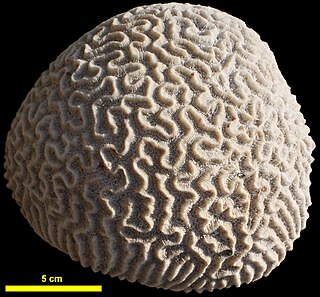
Pseudodiploria clivosa, the knobby brain coral, is a colonial species of stony coral in the family Mussidae. It occurs in shallow water in the West Atlantic Ocean and Caribbean Sea.

Dichocoenia is a monotypic genus of stony coral in the family Meandrinidae. It is represented by a single species, Dichocoenia stokesii, which is commonly known as pineapple coral, elliptical star coral, or pancake star coral. It is mostly found in the Caribbean Sea and the western Atlantic Ocean. Dichocoenia stokesii has irregular calyces and its form can be either a massive, hemispherical hump or a flat, platform-like structure.
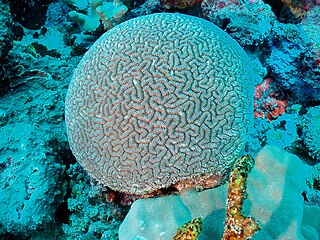
Ctenella is a monotypic genus of stony coral in the family Euphylliidae. It is represented by a single species, Ctenella chagius. These corals are massive in size with meandering valleys between the calyces which have solid, non-porous walls and fine, evenly spaced, solid septae. They are found in the Indian Ocean, Red Sea and Mediterranean Sea. It forms solid, smooth hemispherical domes and is found in the Indian Ocean in the vicinity of the Chagos Archipelago.

Meandrina meandrites, commonly known as maze coral, is a species of colonial stony coral in the family Meandrinidae. It is found primarily on outer coral reef slopes in the Caribbean Sea and the Gulf of Mexico.

Acropora secale is a species of branching staghorn stony coral. It is found in shallow parts of the Indo-Pacific Ocean and the type locality is Sri Lanka. The oldest fossils found date back to the Pleistocene.
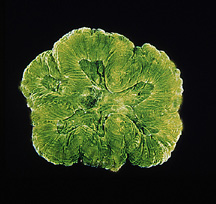
Isophyllia sinuosa, the sinuous cactus coral, is a species of stony coral in the family Mussidae. It is found in shallow water in the tropical western Atlantic and the Caribbean Sea.

Mussa is a genus of stony coral in the family Faviidae. It is monotypic, being represented by the single species Mussa angulosa, commonly known as the spiny or large flower coral. It is found on reefs in shallow waters in the Caribbean Sea, the Bahamas and the Gulf of Mexico.
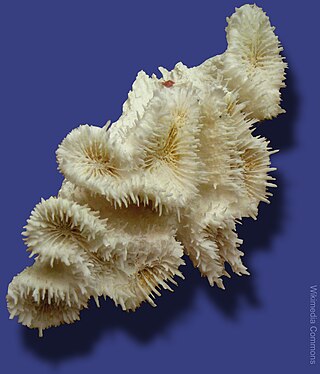
Lobophyllia corymbosa, also known as lobed cactus coral or brain root coral, is a species of large polyp stony coral in the family Lobophylliidae. It occurs on reefs in shallow waters in the Red Sea, off the coast of East Africa, and in other parts of the tropical Indo-Pacific.

Cynarina lacrymalis is a species of stony coral in the family Lobophylliidae. It is variously known as the flat cup coral, solitary cup coral, button coral, doughnut coral, or cat's eye coral. It is found in the western Indo-Pacific Ocean and is sometimes kept in reef aquaria.

Manicina areolata, commonly known as rose coral, is a colonial species of stony coral. It occurs in shallow water in the West Atlantic Ocean and Caribbean Sea, sometimes as small solid heads and sometimes as unattached cone-shaped forms.
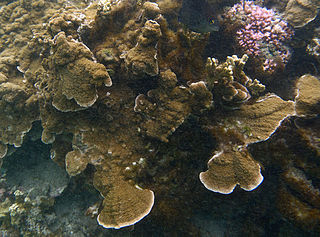
Echinophyllia aspera, commonly known as the chalice coral, is a species of large polyp stony corals in the family Lobophylliidae. It is a colonial coral which is partly encrusting and partly forms laminate plates or tiers. It is native to the western and central Indo-Pacific.
